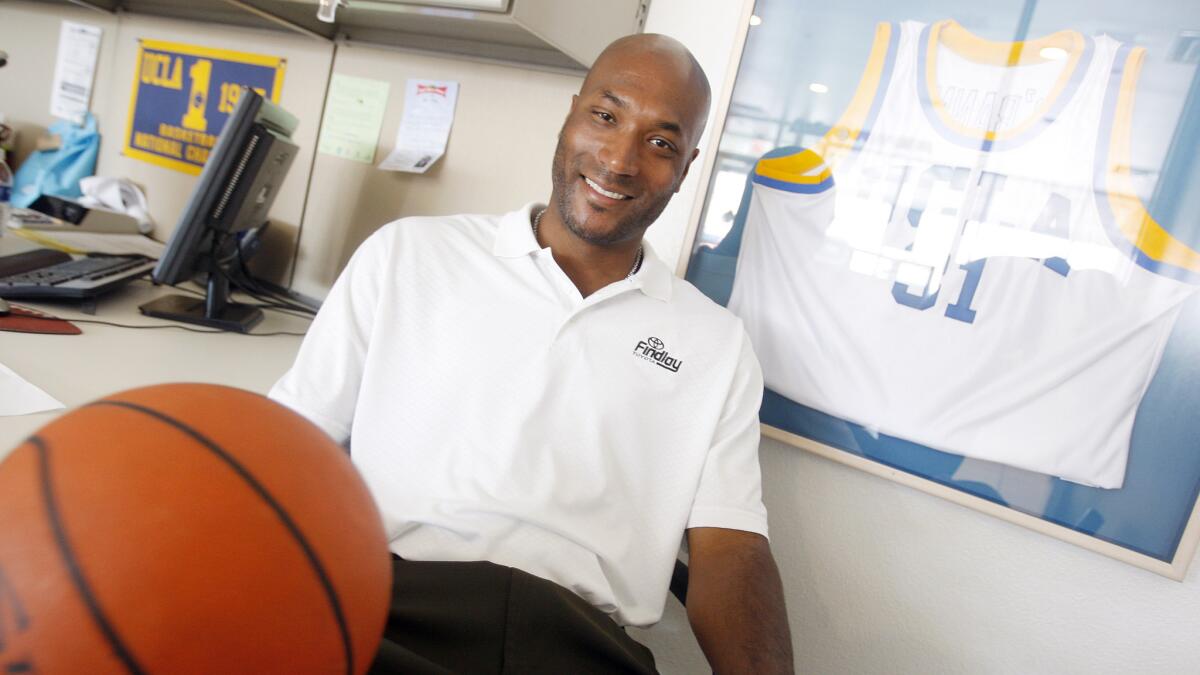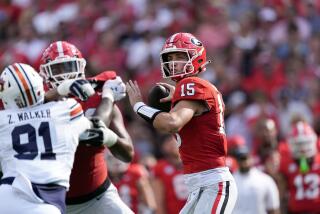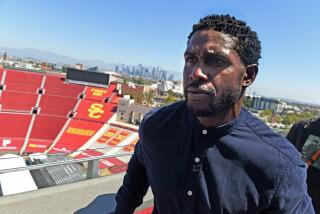NCAA compared to âcartelâ during testimony at antitrust trial

Former UCLA star Ed OâBannon sits in his office in Henderson, Nev., in 2010. OâBannon believes current and former college athletes should receive a share of the revenues generated by the NCAA.
Reporting from Oakland â The federal antitrust trial against the NCAA challenging the multibillion-dollar college sports industryâs compensation practices, and its long-held notion of amateurism, moved through its second day Tuesday with more questioning of a Stanford University sports economist.
The class-action case spearheaded by lead plaintiff Ed OâBannon, a UCLA basketball star in the 1990s, seeks to compel the 108-year-old association to lift restrictions on current and former menâs basketball and football playersâ ability to profit from their names, images and likenesses.
It is one of a handful of converging challenges to the restrictions that the NCAA imposes on its member colleges and conferences with regards to compensation of student-athletes. Plaintiffs deem the system exploitative in an era when revenues from television broadcasts, rebroadcasts, video games and other merchandising deals have exploded, and contends it is anti-competitive, amounting to price-fixing and group dealing.
The NCAA maintains the practices are in the best interest of the holistic collegiate experience of students who happen to be amateur athletes. Its outside counsel spent part of Tuesday trying to rein in the scope of the case and pick legal holes in what remained.
But first, Stanford economist and emeritus professor Roger Noll continued his testimony from Monday under direct questioning by plaintiffsâ attorney Michael Hausfeld.
Noll referred to the NCAA as a âcartelâ that colludes with its member colleges and conferences to depress compensation of student-athletes by predetermining the number and value of scholarships, and requiring student-athletes to give up any right to profit from their likeness while allowing the NCAA to retain the right to do so.
Those âanti-competitiveâ actions, he said, hurt student-athletes and also artificially inflate the costs of coaching and facilities by channeling the bulk of swelling revenues into that arena. Noll reviewed a chart that showed the salaries of college presidents rising 108% between 1985 and 1986, and 2009 and 2010, while compensation for football coaches increased by 512%.
Another chart showed growing spending on facilities, expenditures that Noll contended âwould go down if the exploitation were reduced.â Even modest loosening of restrictions on pay for student-athletes might make a difference, he testified, suggesting one alternative whereby group licensing of names, images and likenesses would be allowed and resulting revenue divided equally among all players on a team. That would ensure that the best players are not singled out for higher compensation.
NCAA outside counsel Rohit Singla next cross-examined Noll in a largely testy exchange that at times appeared to frustrate U.S. District Court Judge Claudia Wilken, who is presiding over the non-jury trial.
Singla stressed that âpay for playâ was not an issue in the OâBannon litigation â another pending case directly challenges scholarship caps â and on several occasions tried to narrow the scope of testimony.
As for rights to names, images and likeness, he challenged Noll to give an example of any effort by the NCAA to interfere with a former student-athleteâs try to be compensated for an endorsement or other use of his image after he stopped playing college ball.
âThereâs no restriction on former athletes that can be enjoined right now,â he said to Noll.
Noll countered that the NCAA rules were vague but appeared to preclude an athlete such as OâBannon from trying to receive compensation for images depicting him while at UCLA because it would suggest an implicit promise to current recruits. He might also run afoul of NCAA intellectual property rights, Noll said.
On the topic of video games, Singla pressed Noll on whether there was a market for licensing of the student-athlete names, images and likenesses, known in legalese as âNILs,â since the games that are the subject of the OâBannon litigation have been phased out.
âAs we sit here today there is no market for students to license their NILs for video games,â he said.
Countered Noll: âThere is a market, there are just at this point no transactions.â
Singla also noted that the NILs of students were never explicitly licensed to game maker Electronic Arts, which was not permitted to use âreal-lifeâ imagery or likeness. (Instead, EA used approximations. For example, OâBannon moved to sue after seeing an avatar in a game that shared his UCLA No. 31 jersey, handled the ball with his left hand, was bald like OâBannon and shared the same complexion.)
Electronic Arts and Collegiate Licensing Co. in late May agreed to pay $40 million in damages to thousands of football and basketball players whose avatars had appeared in the games as a settlement to a trio of lawsuits, and partially to the OâBannon class.
On Monday, the NCAA announced it would pay a $20-million settlement in a related case brought by former college quarterback Sam Keller.
As for broadcast rights, Singla peppered Noll with questions about whether any professional team athletes - in the NBA and NFL, for example â have explicitly licensed the use of their individual names, images or likenesses for live television broadcasts. Noll countered that they did not, but that payments from broadcasting deals were negotiated during their collective bargaining.
The issue is likely to permeate the trial, as the NCAA contends that the individual licensing rights that the litigation contends have been violated do not exist.
Attorneys for the OâBannon class said the video game damage settlements, though not an admission usable in court, seem to suggest otherwise.
âThe NCAA is arguing in this case that thereâs no such thing as an NLI right, or a right of publicity -- that that doesnât exist,â said co-lead counsel William Isaacson. âThe fact that they have now settled and [agreed to pay] money definitely sends a signal to the judge, even though itâs not admissible evidence, that these things may have a little bit of value.â
More to Read
Go beyond the scoreboard
Get the latest on L.A.'s teams in the daily Sports Report newsletter.
You may occasionally receive promotional content from the Los Angeles Times.











